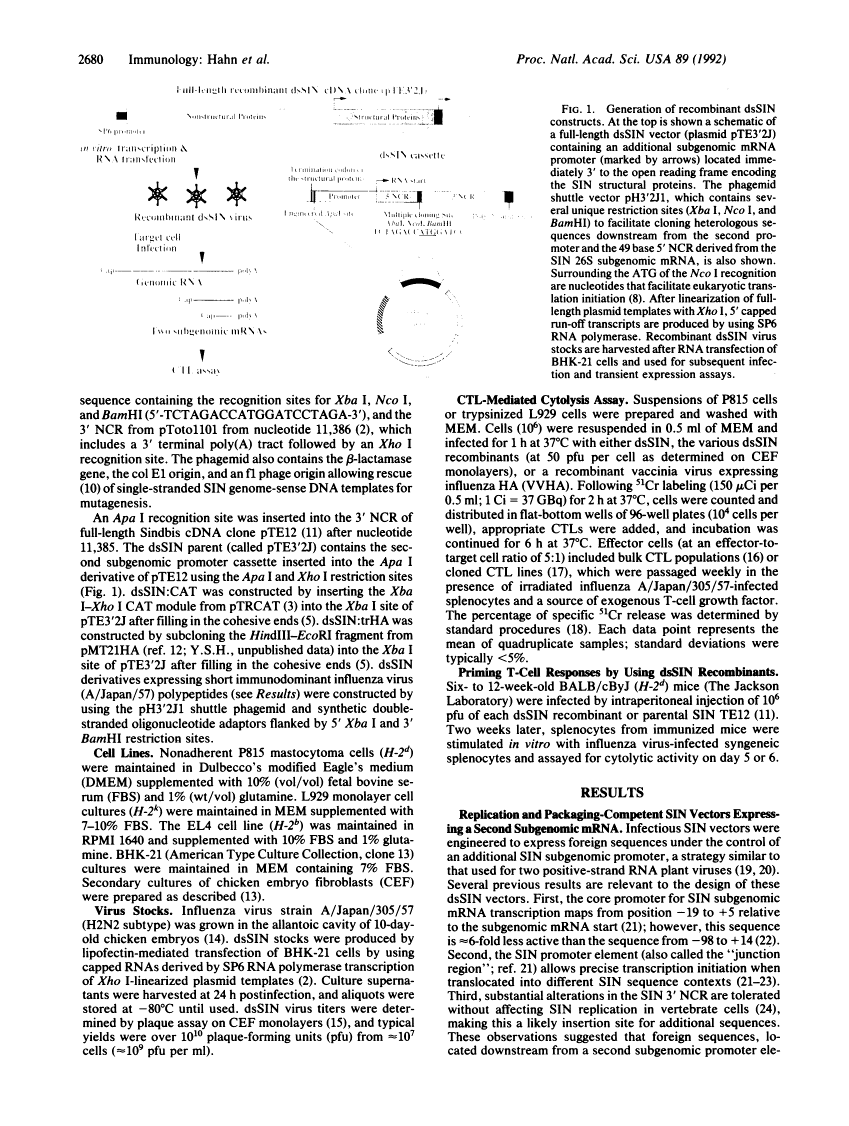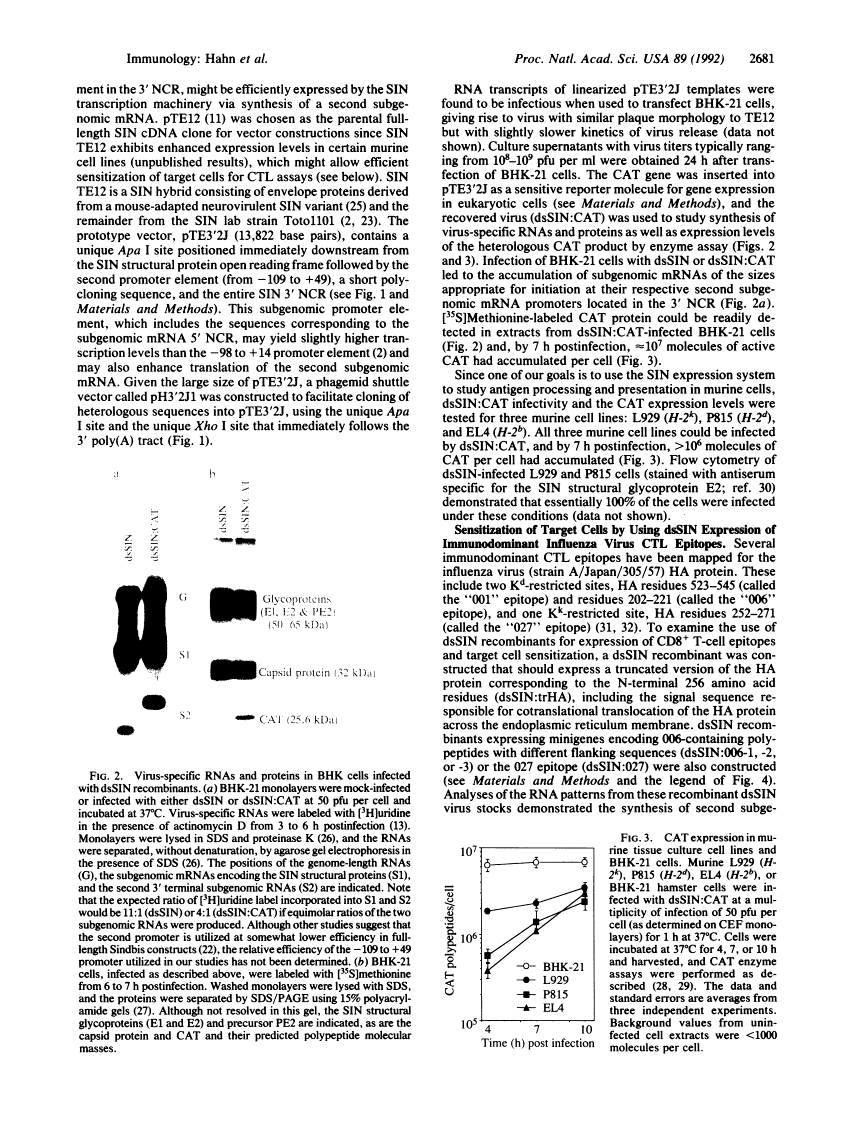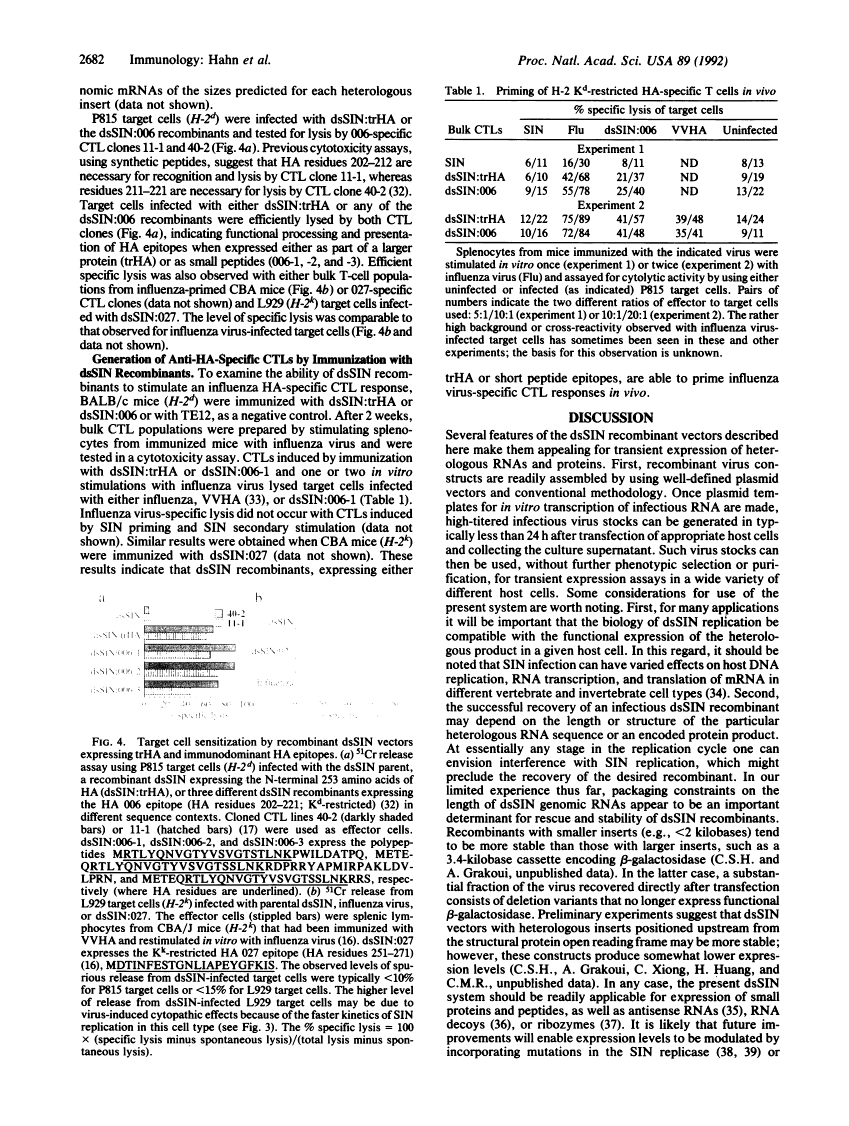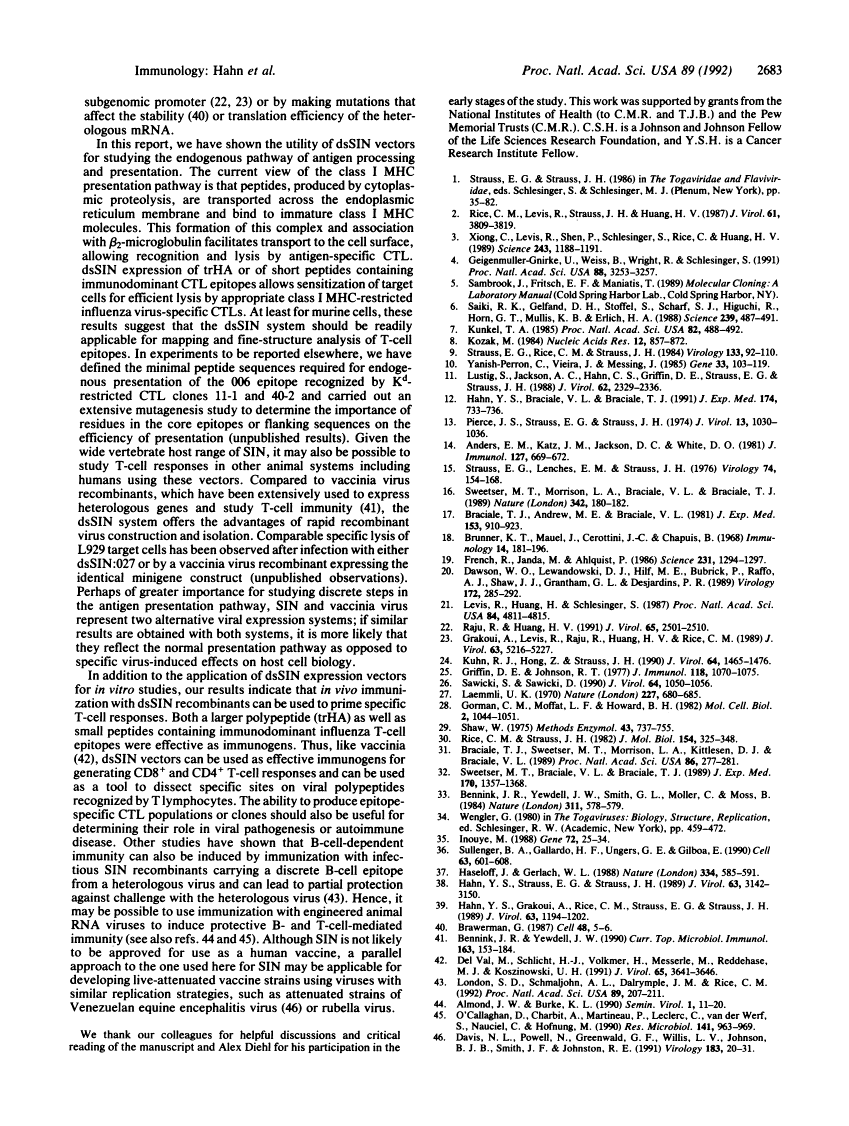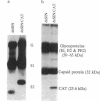Abstract
Free full text

Infectious Sindbis virus transient expression vectors for studying antigen processing and presentation.
Abstract
Sindbis virus (SIN) is a small positive-strand enveloped RNA virus that infects a broad range of vertebrate and insect cells. A SIN vector (called dsSIN), designed for transient expression of heterologous RNAs and proteins, was engineered by inserting a second subgenomic mRNA promoter sequence into a nonessential region of the SIN genome. By using this vector, dsSIN recombinants have been constructed that express either bacterial chloramphenicol acetyltransferase, a truncated form of the influenza hemagglutinin (HA), or mini-genes encoding two distinct immunodominant cytotoxic T lymphocyte (CTL) HA epitopes. Infection of murine cell lines with these recombinants resulted in the expression of approximately 10(6)-10(7) chloramphenicol acetyltransferase polypeptides per cell and efficient sensitization of target cells for lysis by appropriate major histocompatibility complex-restricted HA-specific CTL clones in vitro. In addition, priming of an influenza-specific T-cell response was observed after immunizing mice with dsSIN recombinants expressing either a truncated form of HA or the immunodominant influenza CTL epitopes. This SIN expression system allows the generation of high-titered recombinant virus stocks in a matter of days and should facilitate mapping and mutational analysis of class I major histocompatibility complex-restricted T-cell epitopes expressed via the endogenous pathway of antigen processing and presentation.
Full text
Full text is available as a scanned copy of the original print version. Get a printable copy (PDF file) of the complete article (1.3M), or click on a page image below to browse page by page. Links to PubMed are also available for Selected References.
Images in this article
Selected References
These references are in PubMed. This may not be the complete list of references from this article.
- Rice CM, Levis R, Strauss JH, Huang HV. Production of infectious RNA transcripts from Sindbis virus cDNA clones: mapping of lethal mutations, rescue of a temperature-sensitive marker, and in vitro mutagenesis to generate defined mutants. J Virol. 1987 Dec;61(12):3809–3819. [Europe PMC free article] [Abstract] [Google Scholar]
- Xiong C, Levis R, Shen P, Schlesinger S, Rice CM, Huang HV. Sindbis virus: an efficient, broad host range vector for gene expression in animal cells. Science. 1989 Mar 3;243(4895):1188–1191. [Abstract] [Google Scholar]
- Geigenmüller-Gnirke U, Weiss B, Wright R, Schlesinger S. Complementation between Sindbis viral RNAs produces infectious particles with a bipartite genome. Proc Natl Acad Sci U S A. 1991 Apr 15;88(8):3253–3257. [Europe PMC free article] [Abstract] [Google Scholar]
- Saiki RK, Gelfand DH, Stoffel S, Scharf SJ, Higuchi R, Horn GT, Mullis KB, Erlich HA. Primer-directed enzymatic amplification of DNA with a thermostable DNA polymerase. Science. 1988 Jan 29;239(4839):487–491. [Abstract] [Google Scholar]
- Kunkel TA. Rapid and efficient site-specific mutagenesis without phenotypic selection. Proc Natl Acad Sci U S A. 1985 Jan;82(2):488–492. [Europe PMC free article] [Abstract] [Google Scholar]
- Kozak M. Compilation and analysis of sequences upstream from the translational start site in eukaryotic mRNAs. Nucleic Acids Res. 1984 Jan 25;12(2):857–872. [Europe PMC free article] [Abstract] [Google Scholar]
- Strauss EG, Rice CM, Strauss JH. Complete nucleotide sequence of the genomic RNA of Sindbis virus. Virology. 1984 Feb;133(1):92–110. [Abstract] [Google Scholar]
- Yanisch-Perron C, Vieira J, Messing J. Improved M13 phage cloning vectors and host strains: nucleotide sequences of the M13mp18 and pUC19 vectors. Gene. 1985;33(1):103–119. [Abstract] [Google Scholar]
- Lustig S, Jackson AC, Hahn CS, Griffin DE, Strauss EG, Strauss JH. Molecular basis of Sindbis virus neurovirulence in mice. J Virol. 1988 Jul;62(7):2329–2336. [Europe PMC free article] [Abstract] [Google Scholar]
- Hahn YS, Braciale VL, Braciale TJ. Presentation of viral antigen to class I major histocompatibility complex-restricted cytotoxic T lymphocyte. Recognition of an immunodominant influenza hemagglutinin site by cytotoxic T lymphocyte is independent of the position of the site in the hemagglutinin translation product. J Exp Med. 1991 Sep 1;174(3):733–736. [Europe PMC free article] [Abstract] [Google Scholar]
- Pierce JS, Strauss EG, Strauss JH. Effect of ionic strength on the binding of Sindbis virus to chick cells. J Virol. 1974 May;13(5):1030–1036. [Europe PMC free article] [Abstract] [Google Scholar]
- Anders EM, Katz JM, Jackson DC, White DO. In vitro antibody response to influenza virus. II. Specificity of helper T cell recognizing hemagglutinin. J Immunol. 1981 Aug;127(2):669–672. [Abstract] [Google Scholar]
- Strauss EG, Lenches EM, Strauss JH. Mutants of sindbis virus. I. Isolation and partial characterization of 89 new temperature-sensitive mutants. Virology. 1976 Oct 1;74(1):154–168. [Abstract] [Google Scholar]
- Sweetser MT, Morrison LA, Braciale VL, Braciale TJ. Recognition of pre-processed endogenous antigen by class I but not class II MHC-restricted T cells. Nature. 1989 Nov 9;342(6246):180–182. [Abstract] [Google Scholar]
- Braciale TJ, Andrew ME, Braciale VL. Heterogeneity and specificity of cloned lines of influenza-virus specific cytotoxic T lymphocytes. J Exp Med. 1981 Apr 1;153(4):910–923. [Europe PMC free article] [Abstract] [Google Scholar]
- Brunner KT, Mauel J, Cerottini JC, Chapuis B. Quantitative assay of the lytic action of immune lymphoid cells on 51-Cr-labelled allogeneic target cells in vitro; inhibition by isoantibody and by drugs. Immunology. 1968 Feb;14(2):181–196. [Abstract] [Google Scholar]
- French R, Janda M, Ahlquist P. Bacterial gene inserted in an engineered RNA virus: efficient expression in monocotyledonous plant cells. Science. 1986 Mar 14;231(4743):1294–1297. [Abstract] [Google Scholar]
- Dawson WO, Lewandowski DJ, Hilf ME, Bubrick P, Raffo AJ, Shaw JJ, Grantham GL, Desjardins PR. A tobacco mosaic virus-hybrid expresses and loses an added gene. Virology. 1989 Sep;172(1):285–292. [Abstract] [Google Scholar]
- Levis R, Huang H, Schlesinger S. Engineered defective interfering RNAs of Sindbis virus express bacterial chloramphenicol acetyltransferase in avian cells. Proc Natl Acad Sci U S A. 1987 Jul;84(14):4811–4815. [Europe PMC free article] [Abstract] [Google Scholar]
- Raju R, Huang HV. Analysis of Sindbis virus promoter recognition in vivo, using novel vectors with two subgenomic mRNA promoters. J Virol. 1991 May;65(5):2501–2510. [Europe PMC free article] [Abstract] [Google Scholar]
- Grakoui A, Levis R, Raju R, Huang HV, Rice CM. A cis-acting mutation in the Sindbis virus junction region which affects subgenomic RNA synthesis. J Virol. 1989 Dec;63(12):5216–5227. [Europe PMC free article] [Abstract] [Google Scholar]
- Kuhn RJ, Hong Z, Strauss JH. Mutagenesis of the 3' nontranslated region of Sindbis virus RNA. J Virol. 1990 Apr;64(4):1465–1476. [Europe PMC free article] [Abstract] [Google Scholar]
- Griffin DE, Johnson RT. Role of the immune response in recovery from Sindbis virus encephalitis in mice. J Immunol. 1977 Mar;118(3):1070–1075. [Abstract] [Google Scholar]
- Sawicki SG, Sawicki DL. Coronavirus transcription: subgenomic mouse hepatitis virus replicative intermediates function in RNA synthesis. J Virol. 1990 Mar;64(3):1050–1056. [Europe PMC free article] [Abstract] [Google Scholar]
- Laemmli UK. Cleavage of structural proteins during the assembly of the head of bacteriophage T4. Nature. 1970 Aug 15;227(5259):680–685. [Abstract] [Google Scholar]
- Gorman CM, Moffat LF, Howard BH. Recombinant genomes which express chloramphenicol acetyltransferase in mammalian cells. Mol Cell Biol. 1982 Sep;2(9):1044–1051. [Europe PMC free article] [Abstract] [Google Scholar]
- Shaw WV. Chloramphenicol acetyltransferase from chloramphenicol-resistant bacteria. Methods Enzymol. 1975;43:737–755. [Abstract] [Google Scholar]
- Rice CM, Strauss JH. Association of sindbis virion glycoproteins and their precursors. J Mol Biol. 1982 Jan 15;154(2):325–348. [Abstract] [Google Scholar]
- Braciale TJ, Sweetser MT, Morrison LA, Kittlesen DJ, Braciale VL. Class I major histocompatibility complex-restricted cytolytic T lymphocytes recognize a limited number of sites on the influenza hemagglutinin. Proc Natl Acad Sci U S A. 1989 Jan;86(1):277–281. [Europe PMC free article] [Abstract] [Google Scholar]
- Sweetser MT, Braciale VL, Braciale TJ. Class I major histocompatibility complex-restricted T lymphocyte recognition of the influenza hemagglutinin. Overlap between class I cytotoxic T lymphocytes and antibody sites. J Exp Med. 1989 Oct 1;170(4):1357–1368. [Europe PMC free article] [Abstract] [Google Scholar]
- Bennink JR, Yewdell JW, Smith GL, Moller C, Moss B. Recombinant vaccinia virus primes and stimulates influenza haemagglutinin-specific cytotoxic T cells. Nature. 1984 Oct 11;311(5986):578–579. [Abstract] [Google Scholar]
- Inouye M. Antisense RNA: its functions and applications in gene regulation--a review. Gene. 1988 Dec 10;72(1-2):25–34. [Abstract] [Google Scholar]
- Sullenger BA, Gallardo HF, Ungers GE, Gilboa E. Overexpression of TAR sequences renders cells resistant to human immunodeficiency virus replication. Cell. 1990 Nov 2;63(3):601–608. [Abstract] [Google Scholar]
- Haseloff J, Gerlach WL. Simple RNA enzymes with new and highly specific endoribonuclease activities. Nature. 1988 Aug 18;334(6183):585–591. [Abstract] [Google Scholar]
- Hahn YS, Strauss EG, Strauss JH. Mapping of RNA- temperature-sensitive mutants of Sindbis virus: assignment of complementation groups A, B, and G to nonstructural proteins. J Virol. 1989 Jul;63(7):3142–3150. [Europe PMC free article] [Abstract] [Google Scholar]
- Hahn YS, Grakoui A, Rice CM, Strauss EG, Strauss JH. Mapping of RNA- temperature-sensitive mutants of Sindbis virus: complementation group F mutants have lesions in nsP4. J Virol. 1989 Mar;63(3):1194–1202. [Europe PMC free article] [Abstract] [Google Scholar]
- Brawerman G. Determinants of messenger RNA stability. Cell. 1987 Jan 16;48(1):5–6. [Abstract] [Google Scholar]
- Bennink JR, Yewdell JW. Recombinant vaccinia viruses as vectors for studying T lymphocyte specificity and function. Curr Top Microbiol Immunol. 1990;163:153–184. [Abstract] [Google Scholar]
- Del Val M, Schlicht HJ, Volkmer H, Messerle M, Reddehase MJ, Koszinowski UH. Protection against lethal cytomegalovirus infection by a recombinant vaccine containing a single nonameric T-cell epitope. J Virol. 1991 Jul;65(7):3641–3646. [Europe PMC free article] [Abstract] [Google Scholar]
- London SD, Schmaljohn AL, Dalrymple JM, Rice CM. Infectious enveloped RNA virus antigenic chimeras. Proc Natl Acad Sci U S A. 1992 Jan 1;89(1):207–211. [Europe PMC free article] [Abstract] [Google Scholar]
- O'Callaghan D, Charbit A, Martineau P, Leclerc C, van der Werf S, Nauciel C, Hofnung M. Immunogenicity of foreign peptide epitopes expressed in bacterial envelope proteins. Res Microbiol. 1990 Sep-Oct;141(7-8):963–969. [Abstract] [Google Scholar]
- Davis NL, Powell N, Greenwald GF, Willis LV, Johnson BJ, Smith JF, Johnston RE. Attenuating mutations in the E2 glycoprotein gene of Venezuelan equine encephalitis virus: construction of single and multiple mutants in a full-length cDNA clone. Virology. 1991 Jul;183(1):20–31. [Abstract] [Google Scholar]
Associated Data
Articles from Proceedings of the National Academy of Sciences of the United States of America are provided here courtesy of National Academy of Sciences
Full text links
Read article at publisher's site: https://doi.org/10.1073/pnas.89.7.2679
Read article for free, from open access legal sources, via Unpaywall:
http://www.pnas.org/content/89/7/2679.full.pdf
Citations & impact
Impact metrics
Article citations
CRISPR-based engineering of RNA viruses.
Sci Adv, 9(37):eadj8277, 13 Sep 2023
Cited by: 3 articles | PMID: 37703376 | PMCID: PMC10499312
Development of a Novel Chikungunya Virus-Like Replicon Particle for Rapid Quantification and Screening of Neutralizing Antibodies and Antivirals.
Microbiol Spectr, e0485422, 01 Mar 2023
Cited by: 1 article | PMID: 36856407 | PMCID: PMC10101068
A new anterograde trans-synaptic tracer based on Sindbis virus.
Neural Regen Res, 17(12):2761-2764, 01 Dec 2022
Cited by: 5 articles | PMID: 35662226 | PMCID: PMC9165366
Development of a hybrid alphavirus-SARS-CoV-2 pseudovirion for rapid quantification of neutralization antibodies and antiviral drugs.
Cell Rep Methods, 2(3):100181, 24 Feb 2022
Cited by: 8 articles | PMID: 35229082 | PMCID: PMC8866097
The Honey Bee Gene Bee Antiviral Protein-1 Is a Taxonomically Restricted Antiviral Immune Gene.
Front Insect Sci, 1:749781, 20 Oct 2021
Cited by: 2 articles | PMID: 38468887 | PMCID: PMC10926557
Go to all (140) article citations
Similar Articles
To arrive at the top five similar articles we use a word-weighted algorithm to compare words from the Title and Abstract of each citation.
Sindbis vectors suppress secretion of subviral particles of Japanese encephalitis virus from mammalian cells infected with SIN-JEV recombinants.
Virology, 209(1):155-166, 01 May 1995
Cited by: 17 articles | PMID: 7747465
Characterization of two distinct major histocompatibility complex class I Kk-restricted T-cell epitopes within the influenza A/PR/8/34 virus hemagglutinin.
J Virol, 65(10):5401-5409, 01 Oct 1991
Cited by: 27 articles | PMID: 1716691 | PMCID: PMC249021
Presentation by a major histocompatibility complex class I molecule of nucleoprotein peptide expressed in two different genes of an influenza virus transfectant.
J Exp Med, 181(1):203-213, 01 Jan 1995
Cited by: 5 articles | PMID: 7528768 | PMCID: PMC2191835
Class I MHC-restricted recognition of cells expressing a gene encoding a 41 amino acid product of the influenza hemagglutinin.
J Immunol, 141(10):3324-3328, 01 Nov 1988
Cited by: 16 articles | PMID: 2460530

